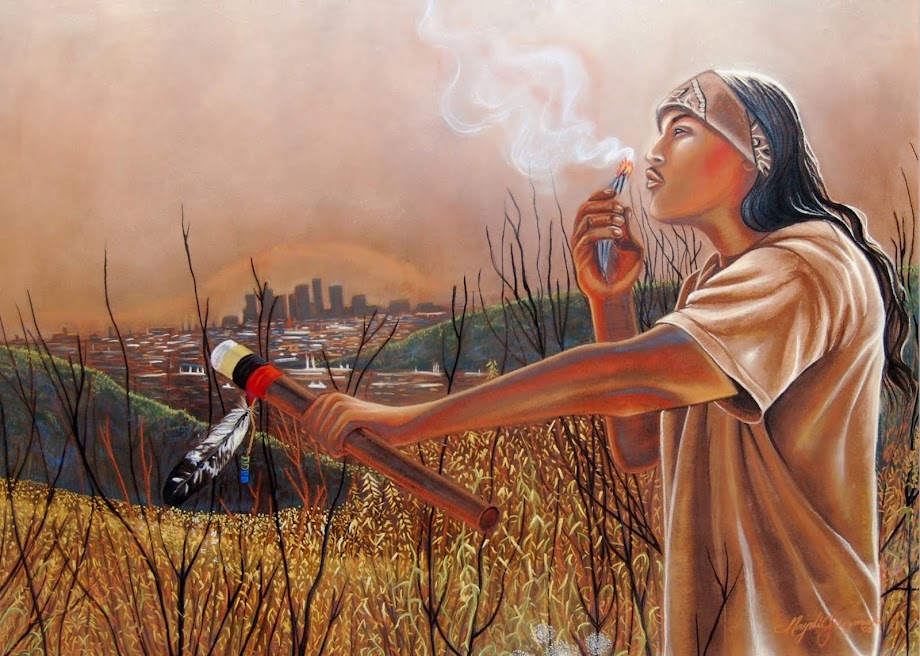 |
| Margaret speaking to students at San Francisco State University. Photo Credit: Javier Moreno-Vega |
Author: Diego Mulato Castillo
I recall my father bringing home stone arrowheads. Rubbing his thumb against the carved edge of the stone, he said, “...you can even tell that it is a little sharp here.” My father had always told me stories about Native peoples of El Salvador, especially the Pipiles, who built the ancient ruins of El Tazumal and San Andres.
It is sad, that in El Salvador, a large portion of the population prefers to claim Spanish heritage.
In Margaret Ramos' film, Ser Salvadoreño es ser Medio Muerto, it was shocking for me to see a news clip of a person who occupied a seat in government claim that there are no longer any individuals of direct Indigenous ancestry in the country. He concluded by stating that, perhaps there were a few individuals in the Western provinces of the country, but not enough to be counted as a significant population. I found it disturbing that the man not only failed to address his own Indigenous ancestry, but also claimed that individuals of Indigenous descent are not worth mentioning, or counted as Salvadoreños.
Margaret illustrated in her film how the massacre of 1932 in El Salvador, crippled the Indigenous population of the country. I had prior knowledge about the event, known as La Matanza, but it was a topic which I had never encountered in a classroom setting. I believe it is important to raise awareness regarding the massacres that occurred in El Salvador, and throughout Central America, so that both Salvadoreños and individuals from different backgrounds may learn about these tragedies.
Growing up, I felt that my experience and history was completely absent from my surroundings. Since middle school I can recall being assigned history books, and always flipping to the index looking for my homeland. To my dismay, if not absent, El Salvador only occupied a few paragraphs at most in the history textbooks. One grows up in a form of limbo, when one’s history and culture are completely erased from their lives. Margaret’s film not only brings attention to the genocidal trauma in El Salvador, but also allows individuals of Salvadoran descent to no longer be invisible—because representation matters.
She also shared her thoughts on Roque Dalton, an incredible poet and social critic who was assassinated at the start of the civil war. Once again, I already knew and had read poetry by Roque Dalton, but to learn about him in a classroom setting was a warming experience.
Then, I experienced for the first time a side of El Salvador which I had never known. In her film, not only did she touch on the Native influence in El Salvador, but also on the legacy of Africans who were brought as slaves. I was unaware that African slaves had been at one time brought to El Salvador to work in plantations. It was eye opening to me, and it was the first time I had ever heard someone refer to themselves as an Afro-Salvadoreña.
After her film and lecture on the Indigenous and African roots buried deep in El Salvador, I interviewed Margaret regarding this complex legacy and her experience as an Afro-Salvadoreña.
DM: There is a quote by Junot Diaz that goes, "If you want someone to obsess about a place burn it to the ground in their lives." Would you say that this quote speaks to your experience as an Afro-Salvadoreña and the erasure of places, peoples, and events in El Salvador?
MR: That is a powerful quote. Yes, I can relate to this quote because there is a certain impact that happens when your history is erased. When your history is not made visible or systematically eliminated, this causes a lack of resource, connection, and identity.
DM: El Salvador, despite being a small country possesses a rich cultural legacy. According to you how has an African and Indigenous legacy shaped El Salvador?
MR: It is visible in its music, dancing, its story telling and some of its spirituality. It is hard to provide examples since there are not many documentations. However, we hear it in our music, and dancing. The Indigenous spirituality is important because there is a lot of humility in the culture.
DM: How do you see public awareness regarding the African and Native legacy in El Salvador changing? And what are your hopes for the future, as well as your message to a younger generation of Salvadoreñas/os growing up either in El Salvador or in the United States?
MR: There is now more of a visibility and empowerment in the Afro Salvadoran and Indigenous identity. Women are claiming their nappy hair and their skin "morena." There is now some documents and interest in the history of these identities. I think my message to the younger generation is to think for yourself, question everything around you and get connected to your ancestry. It is important to know where you came from and to know your story.
Diego Mulato Castillo is currently attending San Francisco State University and is pursuing a degree in Literature with a minor in Latina/o Studies. He resides in Sebastopol, California and enjoys reading and hiking.
Margaret Ramos is an Afro Salvadoran from Los Angeles, California, who currently works with English Language learners at a middle school in Santa Monica. To schedule a film showing or speaking engagement she may be contacted at: meramos2@gmail.com.
